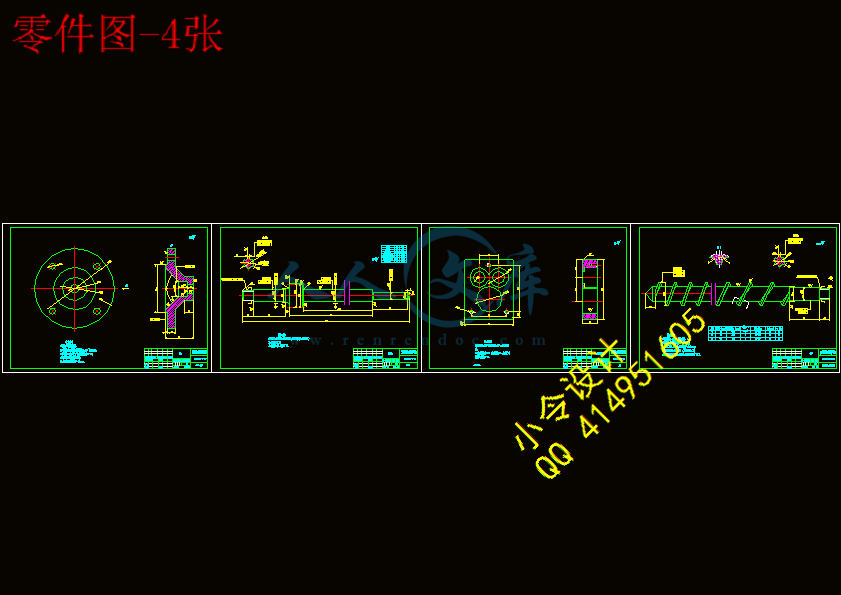摘 要
本文分析了单螺杆挤压机与双螺杆挤压机的特点以及鱼肉仿真食品生产工艺的需要,确定了先通过单螺杆挤压机进行蒸煮、搅拌,再用双螺杆挤压成型机成型的生产流程。在现有挤压机的基础上,并参考了国内外比较成熟的挤压机设计方法,根据鱼肉仿真食品的的特殊工艺要求,对挤压机的关键部位进行了相应的改进。本文详细的介绍了挤压机的主要零部件分配箱、螺杆、机筒等的结构设计,并进行了相应的校核计算;对主要传动零部件如分配箱大小齿轮,带轮、从动轴、键等进行了设计和强度校核,并对轴承承载能力、寿命进行了校核计算;本文还涉及了挤压机一些辅助元件如加料系统、加热冷却装置、模头装置的选择要求,并进行了简单的设计。最后,本文介绍了一些关于挤压机的安装、操作、控制和维护等方面的内容。
关键词:齿轮;分配箱;双螺杆挤压机
Abstract
This article analyzed the food simulation market demand and the production present situation first, through analysis to the prawn cracker and as well as with the traditional processing craft contrast from the theory to use the extruder to produce the food craft feasibility and the economical feasibility. Next, analyzes the single screw rod extruder with the double screw rod extruder characteristic as well as the production craft need, had determined digestion and agitation through the single screw rod extruder first, then uses the double screw rod to extrude the shaper formation the production process. In the base of the extruders in existence, we referenced the mature means of extruder design in our country and abroad and the special working craftwork requires of the snack foods, then, we improved the key structure of extruder. In this text, we introduced the structure design of extruder in detail, particular to the major parts: assignment tank, screw, barrel and systems analysis and calculating. To those important transmission parts: the big gear and the small gears in assignment tank, strip wheel, driving spindle, key, we made a design and check the intensity. And we calculate and check the carrying capacity of the bearing particularly. We also refer to the choosing requirements of the accessories: heating and cooling system, die, knife equipment, and made a simple design. In the end of the text, the installing, operation, controlling and repairing of the extruder were also introduced.
Keywords: gears;assignment tank;Twin-screw Extruder
目 录
摘 要III
AbstractIV
目 录V
1 绪论1
1.1 本课题的研究内容和意义1
1.2 国内外的发展概况3
1.3 本课题应达到的要求5
2 双螺杆挤压机设计7
2.1 双螺杆挤压机的工作原理7
2.2 挤压加工系统7
2.2.1 挤压加工系统组成7
2.2.2 常用挤压术语8
2.3 双螺杆挤压机零部件结构设计8
2.3.1 总体结构设计8
2.3.2 螺杆结构设计8
2.3.3 机筒结构设计13
2.3.4 加料系统13
2.3.5 加热和冷却装置系统13
2.3.6 模板装置14
2.4 双螺杆挤压机零部件设计计算15
2.4.1 主传动系统的设计计算15
2.4.2 主要传动零部件设计计算和校核16
2.4.3 螺杆推力的传递21
2.4.4 螺杆的强度计算23
2.4.5 机筒结构的设计25
2.4.6 模头结构设计25
2.4.7 润滑油的选用26
3 双螺杆挤压机的操作27
3.1 双螺杆挤压机的安装27
3.2 挤压加工系统的操作与维护27
3.2.1 挤压机的开车27
3.2.2 开车操作注意事项27
3.2.3 挤压机维护保养27
4 结论与展望29
4.1 结论29
4.2 不足之处及未来展望29
致 谢31
参考文献33
1 绪论
1.1 本课题的研究内容和意义
二十一世纪是海洋的世纪,海洋占地球总面积的百分之70以上,蕴藏着极为丰富的天然资源, 它是全球生命支持系统的重要组成部分,是保证人类可持续发展的重要财富。当今世界越来越多的国家己将开发海洋作为获取资源、扩大生存空间、推动经济发展的重点战略。我国是一个海洋大国,领海辽阔,海洋资源十分丰富,开发前景诱人。海洋经济将成为我国二十一世纪新的重要产业。
我国又是个淡水渔业大国,有着广袤的内陆水域,水产品资源非常丰富。改革开放后,我国淡水渔业的发展也非常迅速。1979年全国水产品总产量只有470万吨,1989年增至1150万吨,到1993年为1500万吨,1997年己达到3206万吨。
在海洋资源与淡水资源中,又数鱼类产量最大。仅淡水鱼产量而言,1990年产量己达到523万吨,1995年为1078万吨,1997年已为1425万吨。
鱼类食品被公认为一种优质的保健食品,它富含蛋白质,并且其蛋白质容易被人体消化吸收,利用率高,鱼类脂肪含量少并且多由不饱和酸组成,其营养价值要髙于其它动植物脂肪,鱼肉中钙、锌、磷等一些无机盐含量比畜禽肉类还要高,经常食用鱼肉,可改善调节人们膳食结构的合理性,促进儿童少年骨骼生长,加快青年身体发育,预防中老年因缺钙而引起的骨质疏松症。鱼体内还蕴含着丰富的亚油酸、亚麻酸与一定量的二十碳五烯酸、二十二碳六烯酸,它们是构成人脑非常重要的营养素,对人的智力水平起决定作用,在国际上被誉为“能使人聪明的食品”,日本有“食鱼能使头脑变得聪明”的古语,它还具有降低血脂、抗血栓和健脑益智等功效。因而对我们人类来说,鱼肉不仅提供维持身体机能不可缺少的营养物质,而且起到强身健体、延寿增智的效用,因而,鱼肉成为人们日常生活膳食结构中及其重要的一个环节[1]。
鱼类中不缺乏有一些价值较高的经济鱼类,还有数量相当可观的低值鱼类,伴随着海洋渔业的生产发展,经济鱼类产量逐年减少,小杂鱼、低值鱼产量逐年增多。淡水养殖鱼类中鲢鱼等一些低值鱼产量很大,比如浙江千岛湖等水库、河流中以鲢鱼产量为最大。这些低值鱼因为食用不便、口感不佳等原因,没有得到充分的利用,产区有大量的低值鱼要么被低价抛售,要么被无人问津而腐烂掉,这就使得优质鱼肉蛋白及其它营养素的浪费,导致渔民收入的降低,还造成了对环境的污染。怎样加工低值小杂鱼,如何充分开发利用其丰富的蛋白质资源,已引起世界各国的重视。 在开发利用这些低值鱼方面,将它们加工成为鱼糜制品是目前最有效的利用方法之一。
目前鱼糜生产工艺己相当成熟,我省就有好几家较大的鱼糜生产企业,如中外合资舟山兴业有限公司、中日合资龙生水产制品有限公司玉环分公司等,鱼糜生产能力较大,但仅仅作为鱼丸等初级鱼糜制品的原料,造成幵工不足、设备大量闲置。大力开发鱼肉仿真食品,是积极消化并增加鱼糜产量的最佳途径。
日式鱼糜制品的主要品种是模拟蟹腿等仿真食品,通过以下四种加工方法获得,即压模型、 纤维型、复合压模型以及乳化型。压模型是通过单挤压或者共挤压将鱼糜糊压制成需要的形状,并使其凝固,形成弹性凝胶体。纤维型是将鱼糜糊通过有窄的长方形的喷嘴挤压成薄片,然后将薄片加热使其凝固,再切成所需宽度的条状物,将条状物经过成形机拧成绳状物。复合压模型是将鱼糜糊与肉条混合后挤压成所需形状,制成咀嚼感很好、组织结构均匀、弹性较高的制品。乳化型是在加入油脂乳化后的鱼糜糊灌入包衣中再加热使其凝固。
仿真食品的质量可分解成三部分质量,它们是:口感、外形和口味,而影响他们的加工工艺也可以分解为成形部分工艺、调味部分工艺和配合部分工艺。
调味部分工艺
该部分工艺是保证被仿真对象与制品的口味相似。例如,模拟虾仁制品应该有天然虾仁的独特风味,模拟蟹肉制品应该要有蟹肉的风味,而鱼肉风味则存在着一些不足,并且作为经过多次漂洗的鱼糜,漂洗过程中呈味液流失,导致鲜味不足,通常要在成形前在鱼糜中添加鲜味剂,如味 精、酱油等,高质量鱼糜制品要加特殊风味调味料,目前在日式鱼糜制品板式鱼糕、鱼肉汉 堡、烤章鱼风味鱼糕、鱼卷中添加各种风味调味料,而在模拟虾仁、模拟蟹肉等仿真食品要添加文献介绍的虾蟹风味的海鲜调味料。
配合部分工艺
该部分工艺保证制品的组织质地与被仿真对象相似。例如,模拟虾仁制品应有天然虾仁独特的纤维组织、强劲的弹性和咀嚼性。由于鱼肉弹性主要来自鱼肉肌原纤维的凝胶强度,釆取措施,尽量提高鱼肉蛋白凝胶强度,可以得到较好的弹性。然而,鱼肉纤维较短,难以 形成类似虾仁的纤维结构和咀嚼性。在鱼糜糊中加入适量的食用纤维是模拟虾仁生产的关键,同时加入少量真虾肉糜及虾汁提取液或虾味素可使模拟虾仁产品更趋完善。美国专利介绍,用鱼肉模拟虾、对虾、尨虾肉时,一份鱼糜中要加入0.1〜3份具有三维网状结构的可食性纤维,混合成形后得到一定形状和尺寸、与真虾具有相似咀嚼感的产品。
最理想的途径是将鱼肉蛋白纤维--组织化鱼肉蛋白作为可食性纤维添加到低值鱼类加工的仿真食品中,因为组织化鱼肉蛋白可以大量添加到鱼糜糊中,从而保证成型品的质量。
釆用物理化学方法使鱼肉蛋白质变成纤维状。目前鱼肉蛋白纤维制作方法主要有单纺丝粘结法(喷丝法)、压延切丝法、高压组织化法、向冷冻法、挤压膨化法、挤压喷丝凝胶法(注射挤出法〉)等本文主要研究为挤压膨化法。
a.挤压膨化法工艺流程
原料-预处理-进料-挤压-在加工-成型-包装
b.挤压膨化法工艺特点
挤压膨化法是利用原料蛋白质(没变性的或变性)在高压、高温以及剪切力的作用下,使蛋白质发生定向排列形成组织结构,最后由于压、温突降而产生膨化,获得组织化蛋白。挤压膨化是仿真食品生产的关键工序,挤出机或喷爆机称是生产的关键设备。
鱼肉仿真工程食品〔简称仿真食品〉,是符合国际趋势的一类鱼糜制品,具代表性的制品有模拟蟹腿、模拟虾仁等。仿真食品是以鱼糜为主要原料,添加一些营养配料,通过特殊手段和加工工艺制成特定的生物体的仿真工程制品,除了要求制品外形逼真外,更为重要的是要求被仿生物体与制品品质相接近。仿真食品因为附加值高、外形美观、营养丰富、烹食方便,易被全社会各种群体接受,特别适宜未成年和老年群体。目前我国对仿真食昴研究相对落后但有着美好前景,中国食品工业协会于一九九六年制定的《“九五”全国食品工业科技发展纲要建议》中把“应用低值鱼为原料加工鱼糜的科技成果,并进一步普及仿真工程食品的新技术,提高产品技术含量和附加值”列为食品工业水产品行业的一个重点战略。
对于仿真食品的研究开发,因为对制品外形与品质有着特殊要求,只有将加工设备与加工工艺作为有机整体来研究,再加上该方面的基础研究相对落后没有跟上,因此难度较大。但是如果研究取得成功,将会带来巨大的社会效益和经济效益。
目前,我国的水产品加工量仅占总产量的10%大部分是以鲜活水产品销售,而日本的水产品加工量占其百分之70左右。鲜活的水产品,因为尚存在保活储存、保鲜运输等重要技术难点,难以对市场提供全面长期的保证,为了防止水产品的早期腐败、提高水产品附加值,必须对加工品废弃物的综合利用以及进行水产品的加工。由于水产品生产的原料的易腐蚀性、集中性与季节性,对水产品加工提出了相当高的要求,也为水产品的加工提供了广阔的空间。
利用同向双螺杆挤压机压缩得到的鱼肉膨化仿真食品具有禽肉的咀嚼感,可以作为生产原料生产出各种不同口味的模拟仿真食品,可以有效合理的开发利用各种低值动物性蛋白源,可以生产出高附加值的产品及相关新型产品;另外由于原料处理只需去除鱼头和内脏、无需剔除鱼骨,不仅提高了营养价值,而且高效、简单,利于工业化生产。
同向双螺杆挤压机弥补了单螺杆挤压机不能对湿料进行挤压处理的缺陷,为高湿的蛋白原料如鱼类、家畜和家禽碎肉下脚料的组织化提供了可行途径。
通过查阅资料确定设计的基本参数,如产量、物料的含水量、螺杆的转速范围、加热的温度和出料的含水量及状态等。
对于本课题而言,我们需要根据模拟虾仁生产的工艺要求来设计一台专门用于生产加工鱼肉的双螺杆挤压机。根据要求,我们做出了一些创新,首先选用了较小长径比的螺杆,采用较深的螺距,来保证物料在机筒内不至停留时间过长,保持产品的口味。为调节产品的口味,生产过程中操作参数经常需要改变,因此螺杆转速调节以及进料量调节是必不可少的,在设计中我们都考虑到了这一点,在实际设计中单螺杆送料挤压机跟双螺杆成型挤压机都采用了调速电机控制,并严格控制了传动比范围,在满足输出转矩的前提下,使电机的调速范围尽量落在实际生产要求转速的调节区域内,充分发挥调速电机的调速优势。通过对挤压机关键结构参数和操作参数的分析,我们发现压力和温度对产品的质量有较大的影响。因此我们专门对模头处的加热冷却系统进行了设计。在均化段采用加热冷却系统来较好的控制温度,使从模头出来的条状物料的物理性能能满足下一工序——成型——的需要。双螺杆中心距限制,给分配箱内轴承的选用和布置提出了较高的要求。在本次设计中,我们设置了推力轴承组了分担载荷,同时设置碟性弹簧以缓冲吸振。在分配箱箱体形式的选择方面,最终采用了组合式箱体结构,这样在维修时,拆装推力轴承组以及齿轮轴都很方便。
通过双螺杆挤压机来改善单螺杆挤压机不能对湿物料进行加工处理的缺陷。提供一种简单高效、可模拟出禽肉咀嚼感的鱼肉挤压膨化食品加工方法。鱼肉加工双螺杆挤压机膨化机的设计包括机筒、与动力装置连接的第一螺杆、第二螺杆,传动系统和加热出料系统的设计和绘制。
1.2 国内外的发展概况
日本、美国、韩国等比较重视水产加工理论与应用的研究,尤其在仿真食品研究方面走在前列,研究开发的模拟蟹肉、模拟虾仁等仿真食品已达到工业化规模化生产的水平,他们 生产的仿真食品设备已远销我国。目前己开发或正在研究的品种有仿生(模拟)蟹肉—、 仿生〔模拟〕虾仁、模拟贝肉、模拟干虾仁、模拟火腿、模拟南瓜、模拟鲍鱼肉、久仿生墨鱼、仿生海胆、海味牛排阅、海洋牛肉等。不过,对这些仿真食品多数品种的研究,仅停留在工艺研究或探讨阶段,离产业化、工业化生产还有很大距离。
我国在该方面硏究相对落后,虽然有吴光宏、张金亮等进行淡水鱼模拟蟹腿肉的工艺研究试验,但自主开发仿真食品生产设备几乎空白。虽然仿真食品发展前景十分诱人,然而由于仿真食品生产技术研究不足,影响了我国在仿真食品产业领域的发展。
仿真食品的生产工艺与设备,将随制品品种有所区别,但在如何使制品成形、如何保证制品品质等方面存在一些共性问题。因此本研容思路是,通过其典型制品一模拟虾仁的生产工艺和设备研究为蓝本,进行仿真食品的研究。
鱼糜糊是形成模拟虾仁质地、口味的基础。鱼糜糊可按成熟的鱼糜糊工艺获得,其工艺 为:原料鱼一预处理〔去鳞、内脏、头尾、主骨刺〉一釆肉--漂洗一脱水一碎肉(精滤)一配料一擂溃(斩拌〉―鱼糜糊。也可以用冻鱼糜,经解冻一碎肉一 配料一擂溃一鱼糜糊。
鱼肉模拟虾仁制品应该有逼真的虾仁外形,需要进行外形的成形。虾仁外形的成形方法大致有以下几种:滚切成形、冲压成形、浇注成形等方法。由于鱼糜糊只有通过加热凝胶后才能定形,因此要求鱼糜糊能构保持在一定形腔中进行加热凝胶。浇注成形较容易实现,可以设想有一副可开可合的模具,而模具内有大虾仁形状的内腔,将鱼糜糊注塑到模具内腔中,再对模具进行加热,等凝胶可脱模后,打开模具,成形后的虾仁落下,美国专利〖139】介绍的方法就是如此。浇注成形方法也适用于模拟蟹肉、模拟贝肉等鱼肉仿真食品的成形,因此有着广泛的应用。
1、仿真食品应用基础研究
研究影响仿真食品生产工艺、生产设备、制品质量的基础问题,主要是对鱼肉特性以及鱼肉特性与仿真食品工程技术关系的研究。
在鱼肉特性研究方面,鱼肉凝胶特性研究成果较多,在制定仿真食品工艺时,可以参考或采用前人研究的鱼肉凝胶体弹性、强度提高措施。鱼肉流变特性虽然有人作过研究,但针对鱼糜糊特性的流变测量方法还有待探讨,具体的流变特性系数有待进一步确定,解决这些问题是本文的研究内容。
在鱼肉流变特性与仿真食品工程技术的关系研究方面,经文献检索尚未见完整报道。由于仿真食品加工中涉及鱼糜糊的输送流动,而流动过程的压力、流量,以及生产能力、设备功率等都和鱼糜的流变特性有着一定联系系。找出它们之间的关系,把它们用于指导食品食品工程技术的研究,是本文的研究内容。
2、仿真食品生产工艺研究
仿真食品质量主要表现在口味、口感和外形上,通过鱼糜糊工艺、鱼丝工艺、仿真食品成形工艺反映出来。目前鱼糜糊工艺已比较成熟,包括配方和工艺流程。而适合机械化生产、工艺简单的鱼丝工艺、仿真食品成形工艺,还有待研究。
3、仿真食品生产设备研究
仿真食品生产设备是仿真食品产业化的关键,虽然国外有仿真食品成形设备的报道,但国产化且符合国情的中小型仿真食品成形设备尚未见。研究中小型仿真食品生产设备,在国内推广使用,也是本文的研究内容。
我国在双螺杆挤压机的设计制造及应用方面与发达国家相比存在很大的差距。由于国内双螺杆挤压机开发与研究工作起步较晚,因此产品档次较低,系列化程度低,多数产品的螺杆、技术水平、机筒的精度、整机性能和质量与目前发达国家的现有水平有一定差距。目前,我国生产的异向旋转双螺轩挤出机多为锥形异向双螺杆挤出机,而平行异向双螺杆挤出机还很少,并且多为中、小型机,国内所需的大型异向双螺杆挤出机几乎全部依赖进口。在双螺杆挤出机的设计、计算以及制造技术方面尚有很多难点需要克服,这些都限制了我国在双螺杆挤出技术与装备领域的发展。
随着我国国民经济的发展,大型塑料管材、板材在石化、建筑、型材、国防等领域的应用日渐广泛。大型平行异向双螺杆挤出机的开发研制也必将受到越来越多的重视。
1.3 本课题应达到的要求
本课题主要研究同向双螺杆挤压机及其传动系统设计,因此双螺杆中心距限制,给分配箱内轴承的选用和布置提出了较高的要求。在本次设计中,我们设置了推力轴承组了分担载荷,同时设置碟性弹簧以缓冲吸振。在分配箱箱体形式的选择方面,最终采用了组合式箱体结构,这样在维修时,拆装推力轴承组以及齿轮轴都很方便。
仿真食品生产设备是仿真食品产业化的关键,虽然国外有仿真食品成形设备的报道,但 国产化且符合国情的中小型仿真食品成形设备尚未见。研究中小型仿真食品生产设备,在国 内推广使用,也是本文的研究内容。
双螺杆挤压机作为一种多输入多输出的新型生化反应器,研究其设计的方法、模型、手段及实验的理论根据等都是十分有意义的。研究双螺杆挤压机需要比较全面的机械、食品、化学、传热学、六边学、流体力学、电子、自动控制等丰富的知识结构。国外的研究趋势表明,需要研制生产能力大,系统稳定性好,产品质量稳定,自动化程度高的挤压设备。
本设计中采用单螺杆输料,然后直接送入双螺杆挤压成型机中。这样,单螺杆挤压机就充当了喂料装置,它不仅能均匀的喂料,且能控制喂料量,满足各种不同物料加工需要,避免进料不均匀的现象,提高产品的质量和产量。
利用双螺杆挤压机压缩得到的鱼肉膨化食品具有禽肉的咀嚼感,可以作为基料生产出各种不同口味的模拟肉食品,可以有效合理的开发利用各种低值动物性蛋白源,可以生产出高附加值的产品及相关新型产品;另外由于原料处理只需去除鱼头和内脏、无需剔除鱼骨,不仅提高了营养价值,而且高效、简单,利于工业化生产,改变了单螺杆挤压机不能对湿料进行挤压处理的缺陷,为高湿的蛋白原料如鱼类、家畜和家禽碎肉下脚料的组织化提供了可行途径。
通过查阅资料确定设计的基本参数,如产量、物料的含水量、螺杆的转速范围、加热的温度和出料的含水量及状态等。
通过双螺杆挤压机来改善单螺杆挤压机不能对湿物料进行加工处理的缺陷。提供一种简单高效、可模拟出禽肉咀嚼感的鱼肉挤压膨化食品加工方法。鱼肉加工双螺杆挤压机膨化机的设计包括机筒、与动力装置连接的第一螺杆、第二螺杆,传动系统和加热出料系统的设计和绘制。





 川公网安备: 51019002004831号
川公网安备: 51019002004831号